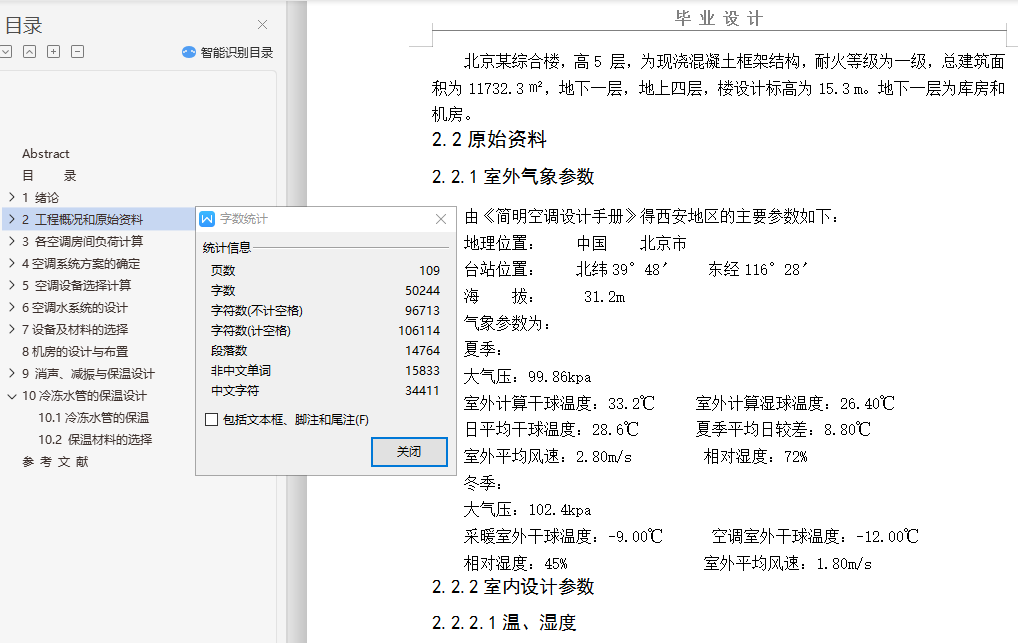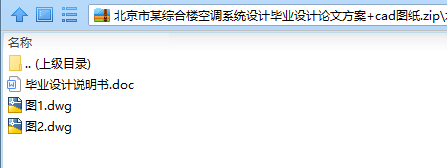北京市某综合楼空调系统设计方案
摘 要
本设计是北京市某综合楼的空调系统设计。此建筑是包括超市、会议室、办公室、客房等于一身的多功能型建筑,总建筑面积为11732.3m2,建筑高度为15.3m,建筑共五层,地上四层,地下一层。制冷机房设在地下一层,冷却塔布置在四层屋面。一层主要为超市和旅馆大堂,二、三、四层主要是会议室,办公室和旅馆。此次暖通空调设计内容包括:集中空调系统(含冷、热源方案的选择)、空调冷却水系统、地下室防烟、排烟以及通风系统的设计。对于层高较高空间较大的房间主要采用全空气系统,对于层高较低空间较小的房间主要采用风机盘管加新风系统。最后还要对空调系统的设备和管路采取消声、防振和保温等措施。
关键词:综合楼 空调系统 冷却水系统
Abstract
The graduation design is the design about the air-conditioning system of a comprehensive building in Beijing. This building is a mal-fuction building, which includes supermarkets, meeting rooms, offices, and guest rooms. Its total area is 11732.2 square meters. The height of the building is 15.3 meters. There are five floors in the building, among them, four floors are on the ground, and one is underground. The generation room of refrigeration system is set up in the basement. The cooling tower is fixed up on the roof of the fourth floor. The supermarkets and the lobby of the hotal are the main room in the first floor. The meeting rooms, offices and the hotal are on the second, third and fourth floors. The content of the heating, ventilation and air-conditioning system design include: central air-conditioning system(include the selection of the cooling and heating source), cooling water of air-conditioning system, prevent and get rid of the smoke in the basement and ventilation system. The complet air system is adopted mainly in the rooms, whose height is more higher and the space is more spacious. And PAU and FCU system is adopted in the other rooms. At last, the measurements of weaken sound, prevent equipment from vibration and insulation are adopted to the equipment of the air-conditioning system and pipeline.
Keyword: comprehensive building; air-conditioning system; cooling water system.
目 录
1 绪论 1
1.1设计目的 1
1.2设计要求 1
1.2.1初步设计 1
1.2.2施工图设计 1
1.2.2.1设计计算 1
1.2.2.2绘图 1
1.2.2.3整理设计文件 1
1.3设计研究现状和发展趋势 2
2 工程概况和原始资料 3
2.1工程概况 3
2.2原始资料 3
2.2.1室外气象参数 3
2.2.2室内设计参数 3
2.2.2.1温、湿度 3
2.2.2.2新风量 4
2.2.2.3噪声要求 4
2.2.3围护结构参数 4
3 各空调房间负荷计算 5
3.1夏季逐时冷负荷计算公式 5
3.1.1外墙和屋面瞬变传热引起的冷负荷 5
3.1.2内围护结构冷负荷 5
3.1.3玻璃窗瞬变传热引起的冷负荷 5
3.1.4透过外玻璃窗日射得热引起的冷负荷 6
3.1.5 设备散热形成的冷负荷 6
3.1.6照明散热形成的冷负荷 7
3.1.7人体散热形成的冷负荷 8
3.2湿负荷计算公式 9
3.2.1人体散湿量 9
3.2.2散湿量敞开水表面散湿量 9
3.3热负荷计算公式 22
3.3.1围护结构的基本耗热量和附加耗热量 22
4空调系统方案的确定 38
4.1空调水系统的选取 38
4.2空调风系统的选取 39
4.2.1 空调系统的划分原则 39
4.2.2 方案比较 40
4.3. 系统选择 41
4.3.1系统选择说明 42
4.4 新风系统 42
5 空调设备选择计算 44
5.1全空气一次回风送风处理过程以及送风参数计算 44
5.1.1确定送风状态点 44
5.1.2全空气系统空调机组的选择计算 46
5.1.3空调机组的布置 47
5.2风机盘管的选择计算 48
5.2.1风机盘管的选择计算 48
5.2.2风机盘管的布置 50
5.3 新风机组的选择计算 50
5.3.1新风机组选择计算 50
5.3.2新风机组的布置 51
5.4空气分布 51
5.4.1布置气流组织分布 51
5.4.2散流器选择计算 52
5.4.3风机盘管侧送风口选择计算 53
5.4.4风机盘管顶送风口选择计算 54
5.4.5喷口选择计算 55
55
5.5风系统水利计算 56
5.5.1计算方法 56
5.5.2系统风管道的水力计算举例 57
5.6风口布置 74
5.7风管的布置及附件: 74
6空调水系统的设计 76
6.1 空调水系统的设计原则 76
6.2水系统水力计算 76
6.2.1 冷冻水系统的水力计算 76
6.2.1.1冷冻水系统的选择 76
6.2.1.2冷冻水系统的水力计算参数 78
6.2.1.3 每层水环路水力计算 80
6.2.2 冷凝水系统的水力计算 94
7设备及材料的选择 96
7.1分水器和集水器的选择 96
7.1.1 分水器和集水器的构造和用途 96
7.1.2 分水器和集水器的尺寸 96
7.2冷水机组的选择 97
7.3冷冻水泵的选择 97
7.4冷却塔的选择 98
7.5冷却水泵的选择 99
7.6板式换热器的选择 100
7.7供热循环水泵的选择 100
7.8补水泵的选择 101
7.9软水器的选择 102
7.10软水箱的选择 102
7.11膨胀水箱的选择 102
8机房的设计与布置 103
9 消声、减振与保温设计 104
9.1消声与隔声设计 104
9.2减振设计 104
9.2.1冷冻机、水泵及风机等设备的减振 104
9.2.2管道减振 104
9.3保温设计 105
9.3.1风管的保温设计 105
10冷冻水管的保温设计 106
10.1冷冻水管的保温 106
10.2 保温材料的选择 106
结论 108
谢辞 109
参 考 文 献 111





